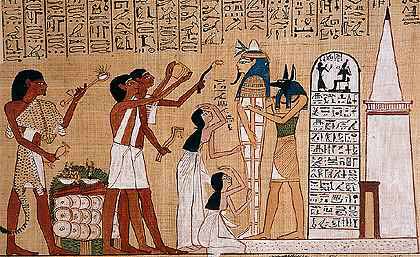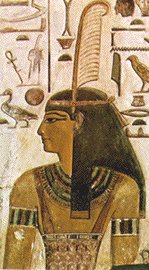Osiris ruled Egypt with his sister, Isis, and his brother Seth, the lord of chaos, grew jealous. Fitting that the jealous brother is the lord of chaos. Seth planned to murder his brother and seize the throne. Seth tricked Osiris and sealed him in a coffin that he flung into the Nile; Osiris drowned and that is how death was created. Isis, who is also Osiris' wife, retrieve his body only to have Seth dismember it and scatter the pieces. Isis enlisted the help of other deities and recovered the pieces and put his body back together with the help of Anubis. Anubis is the god of embalming. By doing this, the first mummy was created. Therefore it is believed that mummies are protected by Osiris. Osiris was able to be resurrected long enough to conceive Horus and then became the lord of the underworld.
 |
| Osiris God of the Underworld |
That is a pretty crazy family for one, but that is how the Egyptians viewed the start of death. Osiris lived on after death and so can they.
The Egyptians are known for mummification. As soon as you think of Egypt your first thoughts are generally pyramids and mummies. The Egyptians didn't start mummifying until around the third dynasty. It was common for the dead to be buried in a pre-dynastic pit burial. It was normally just a hole in the ground with a body placed inside accompanied by personal objects and artifacts. The desert actually preserved the bodies perfect-ally and some historians believe that the Egyptians saw the bodies preserved and came up with mummification. (The sand would blow away and the bodies would resurface)
 |
| Example of pit burial |
In dynasty 3, it is believed that the Egyptians started to wrap their dead. The tomb of Queen Hetephares, from dynasty four, contained 4 canopic jars used to carry internal organs. The oldest mummy in existence, that we know of, is from dynasty 5.
The Egyptians called the mummy the ka, which is like your soul, it lives on after the mortal body perishes. The Egyptians would dehydrate the body by packing it full of natron and let it sit for 30 days. Natron is like modern day baking soda. The lungs,liver, stomach and intestines were removed. The heart was also removed and was believed to be the seat of knowledge while the brain was though useless. They actually started to remove the brain at one point and just threw it away because they thought it was completely useless. They wrapped the body in linen cloth afterwards. Depending on the time period the body was then placed in a sarcophagus inside a tomb.
The burial process was roughly 70 days. This gave the family time to prepare the tomb for goods and for grieving.
Protective amulets were placed inside body wrappings and priests would recite spells that would activate their powers. Spells and incantations can be found in tombs. These are known as Pyramid Texts. You can actually read some of the texts from the Pyramid of Unas. http://www.pyramidtextsonline.com/ Pyramid texts were used to ensure that the dead would be properly taken care of in the afterlife. Text sayings ranged from resurrecting your servants to reassembling your body. Anything the Egyptians thought would be helpful in the journey through the underworld they put in the texts.
Before the body is placed in the coffin, it is covered with a funerary mask that depicts the person as they were living. The body is then carried in a funerary procession. The priest perform the opening of the mouth ceremony which reanimates the ka and senses of the dead. The Book of the Dead contains a text on this. Tools were used to open the mouth and things were placed in front of the face so the dead could smell them.
- My mouth is opened by Ptah,
- My mouth's bonds are loosed by my city-god.
- Thoth has come fully equipped with spells,
- He looses the bonds of Seth from my mouth.
- Atum has given me my hands,
- They are placed as guardians.
- My mouth is given to me,
- My mouth is opened by Ptah,
- With that chisel of metal
- With which he opened the mouth of the gods.
- I am Sekhmet-Wadjet who dwells in the west of heaven,
- I am Sahyt among the souls of On.
The mummy is laid to rest in the tomb and surrounded by grave goods.
 |
| Opening of the Mouth Ceremony |
Mummies may be buried with shabtis, which were magical figurines that came to life and acted as servants. After the burial is complete the deceased makes the journey to the underworld for the weighing of the heart ceremony.
Before the weighing of the heart ceremony the deceased is lead into the Hall of Two Truths , by Anubis, where they were judged by Osiris and 42 gods. They were presented with a list of sins and had to deny each individual one. After this their hearts were weighed.
The weighing of the heart ceremony is judged by Osiris who puts your heart on a scale to make sure it doesn't weigh more than a feather. Peace, balance, truth and goodness were what made up Ma'at, which was represented by a feather. If you had good Ma'at in your life your heart passed and you may pass yourself. If it was heavier than a feather you were fed to Ammut, a monster that ate evil doers. So far no records of anyone actually failing this judgement day have been found.
 |
| Weighing of the Heart Ceremony |
 |
| Physical Representation of Ma'at |
The Egyptians believed that they would live forever in their homeland, which was basically a paradise, after death. They thought it would be just a continuation of their life on Earth. They believed the shabti figures would perform all manual labor. The harvest would be huge and there would be no droughts or diseases. The deceased and their families would enjoy a life of luxury forever. Its crazy how they thought their life would just continue after death just the same, expect they wouldn't have to do anything but relax and enjoy themselves. They pursued this belief vigorously.
Can you imagine believing in this? It sounds amazing to die and live in paradise forever after death. Death wasn't viewed poorly by the Egyptians. Hell, the Kings oversaw the building of their own tombs. They would start building as soon as they obtained the throne! They wanted to ensure that they would be well taken care of in the afterlife and their ka was able to live freely and happily.
I love the Egyptians, their beliefs, culture, customs and just everything. There is so much on Egyptians and their beliefs on death that you couldn't possibly cover it in one day. Let alone one class. I took an Ancient Egypt class with Sharon Park and learned so much. For any fellow Egyptian lovers I recommend this class, it will further your learning,